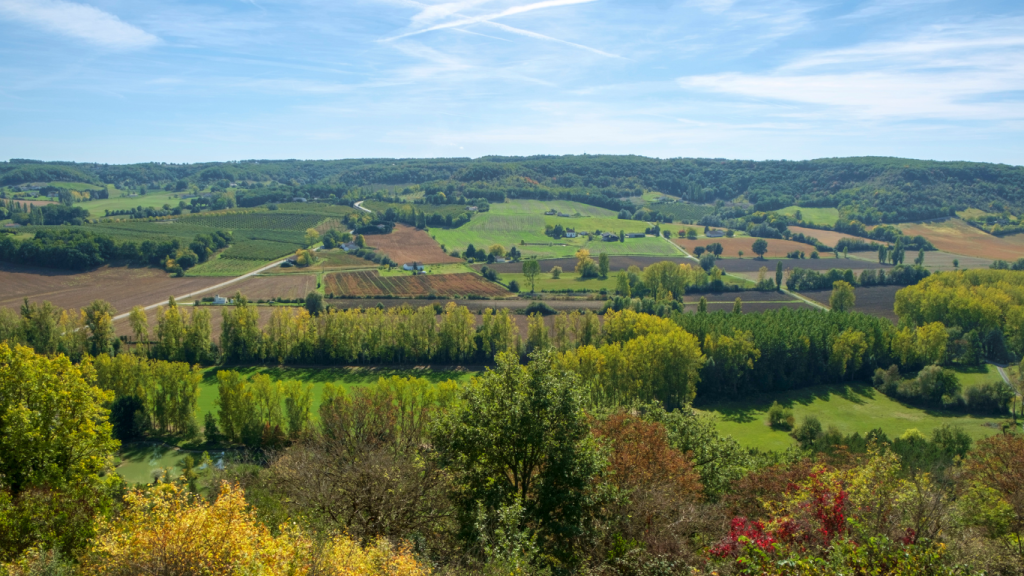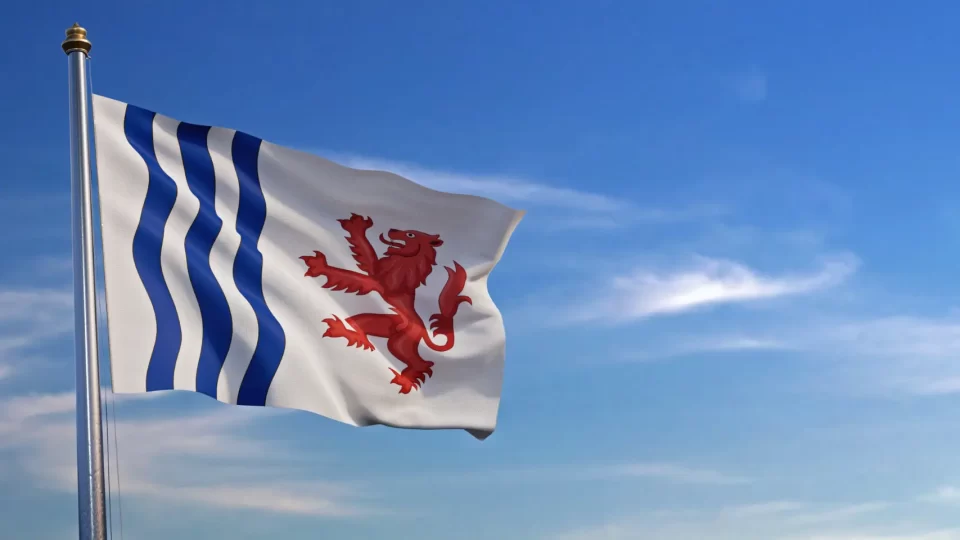Climate and Geography of Nouvelle-Aquitaine
Nouvelle-Aquitaine experiences four distinct seasons and boasts a remarkably diverse array of landscapes. From snow-capped peaks to sun-drenched beaches, and from shaded forests to the allure of urban areas and rural villages, the region offers a vast range of environments and adventures, encapsulating the very essence of France in a single locale!
Climate
Nouvelle-Aquitaine’s climate is predominantly temperate, reflecting its renowned laid-back lifestyle. Sunlight is abundant, averaging between 2,000 to 2,200 hours per year, comparable to some Mediterranean regions. However, noticeable variations exist across different parts of the region:
- The Aquitaine coastal zone spans the majority of Nouvelle-Aquitaine, from Charentes to the Landes. Here, mild winters and relatively warm summers are moderated by coastal breezes.
- The maritime climate of the northwest (Poitou) experiences moderate rainfall, with warm summers and cool, though not excessively cold, winters.
- The Limousin region has a maritime climate influenced by semi-continental factors.
- The Basque Country experiences a maritime micro-climate, characterised by higher humidity levels, covering the western half of Pyrénées-Atlantiques and the southern areas of the Landes.
- The Pyrenees exhibit a mountain climate, with variations in temperature depending on altitude, known as the Pyrenean climate.

Geography
Covering an expanse of 84,036 km², Nouvelle-Aquitaine is the largest region in France, comparable in size to Austria. It comprises twelve departments: Charente, Charente-Maritime, Corrèze, Creuse, Dordogne, Gironde, Landes, Lot-et-Garonne, Pyrénées-Atlantiques, Deux-Sèvres, Vienne, and Haute-Vienne.
1. Expansive Coastline
Nouvelle-Aquitaine’s Atlantic coastline stretches over 720 kilometres and includes an array of islands, each with its own distinctive character, such as Île de Ré, Île d’Oléron, Île d’Aix, and Île Madame, all of which are worth exploring! With a rich history as a popular seaside destination, the region boasts renowned resorts like Arcachon, Biarritz, and Royan, as well as being famed for its oyster farming (Marennes-Oléron and Arcachon Bay) and mussel cultivation (Aiguillon Bay). Fishing villages and oyster farms are integral to the region’s unique landscapes and offer delightful strolls while sampling fresh seafood.
The coastline is predominantly bordered by dunes, including the famous Dune du Pilat, Europe’s tallest sand dune. These dunes are intertwined with wetlands, such as the Hourtin Marshes, Gironde estuary, and Poitevin Marshes. Towards the southern reaches of the region, the coastline remains largely untamed and secluded, with only a few coastal resorts dotted among the dunes, including Soulac-sur-Mer, Carcans, Hourtin, Lacanau, Biscarrosse, Mimizan, Capbreton, and those surrounding Arcachon Bay. This expansive lagoon has been protected as the Arcachon Marine Nature Reserve since 2014.
2. Vast Forests
Forests blanket much of Nouvelle-Aquitaine, particularly inland from the coastal dunes. The Landes Forest, spanning a million hectares, stands as Western Europe’s largest man-made forest, while the Coubre Forest covers 8,000 hectares. Additionally, significant expanses of continuous upland forest include the Iraty Forest in the Basque Country, the Double Forest in Dordogne boasting around 500 lakes and ponds, the Moulière Forest near Poitiers, and the Forest of Chabrières near Guéret.
3. Mountainous Terrain
The southern extremity of the region showcases the Pyrenees mountain range, with verdant hills like La Rhune in the west, and rocky landscapes around Pau with peaks exceeding 2,000 metres, such as Pic Palas (2,974 m) and Pic du Midi d’Ossau (2,884 m). Numerous fast-flowing mountain rivers, known as gaves, carve through this rugged terrain, including the Gave de Pau, Gave de Bious, and Gave d’Ossau. The Ossau Valley, one of Béarn’s three great valleys, stretches from Pau to the French-Spanish border, encompassing glacial lakes and protected wildlife within the Pyrenees National Park.
Linked to the Massif Central, Limousin boasts high wooded plateaus above lush valleys and oak-chestnut forests. Noteworthy valleys include the steep-sided valleys of the Vienne, Isle, Vézère, and the picturesque Corrèze. The Limousin mountains comprise various small ranges, such as the Fayat, Monédières, Châlus Hills, Mont Bessou, and Monts de la Marche, characterized by wooded hills interspersed with flatlands.
4. Inland Wonders
The northern section of the region predominantly features agricultural and viticultural zones nourished by shallow valleys bordered by oak forests. Moving southwards, the expansive landscapes of Niortais are mainly dedicated to cereal cultivation, alongside diverse wetlands like the Poitevin Marshes – famously known as Green Venice. Much of this area falls within the Poitevin Marshes Regional Nature Reserve, established in 1979 and now part of the Grand Sites de France network.
Angoumois acts as a transition zone between the coastal plains and the Limousin plateau. The River Charente meanders through its undulating terrain, passing through the cities of Angoulême, Cognac, and Jarnac. Renowned for its wine production, this region is globally acclaimed for its Cognac and Pineau des Charentes. Towards the southern edge of Angoumois, the diverse landscapes of Dordogne encompass woodlands (Périgord Vert), expansive fields of cereals (Périgord Blanc), oak forests, walnut groves, truffle-rich woods (Périgord Noir around Sarlat-la-Canéda), and vineyards (Périgord Pourpre towards Bergerac) renowned for producing world-class wines like Bergerac, Monbazillac, and Pécharmant.

5. Unique Regions
The Gironde estuary presents a distinctive environment. As Europe’s largest unspoiled estuary and a Natural Marine Nature Reserve, it is surrounded by extensive marshlands known as ‘the Little Camargue’ and the slopes where Bordeaux’s finest wines are cultivated: Pauillac, Margaux, Saint-Estèphe, Saint-Julien, and more. At its end lies the Entre-deux-Mers vineyard, famous for its dry and sweet white wines such as Cadillac, Loupiac, and Sainte-Croix-Du-Mont. Across the river, the Libournais vineyard to the north (Pomerol, Saint-Émilion, and Fronsac), Graves (Pessac-Léognan), and Sauternes (Sauternes and Barsac) to the south, contribute to Bordeaux’s global wine prestige.
The Landes de Gascognes (Haven of Thermal Springs) – South of Bordeaux, between the Atlantic coast and the Garonne’s left bank, stretches the vast plain of Landes de Gascogne, housing the Landes Forest and extensive cereal fields. The region also hosts the renowned spa town of Dax.
Lot and Garonne Valleys (Birthplace of Finest Produce) – Lot-et-Garonne is synonymous with agriculture, with Agen famed for its prunes, Marmande for its tomatoes, tobacco, strawberries, and wine (Côtes-du-Marmandais, Côtes de Duras, Buzet, and Côtes du Brulhois). Armagnac, exported worldwide, and the regional fortified aperitif wine known as Floc de Gascogne, are emblematic of the region.
Basque Country and Béarn (Custodians of Tradition) – The southernmost part of the region boasts two distinct local identities: the Basque Country and Béarn. The verdant hills of the Basque Country are dotted with historic towns like Bayonne and Saint-Jean-Pied-de-Port, prestigious coastal resorts such as Biarritz and Saint-Jean-de-Luz, and rural landscapes with vineyards producing Irouléguy wines.
The area also has a rich tradition of livestock farming, with Bayonne Ham and Ossau-Iraty cheese being internationally recognised. Nestled in the heart of the Pyrenees, the hills of Béarn are interspersed with valleys like Aspe, Barétous, and Ossau. Agriculture and viticulture dominate, yielding wines like Jurançon and Madiran, while also hosting prominent winter sports resorts like Artouste, Gourette, Issarbe, La Pierre Saint-Martin, and Le Somport.
Conclusion
Nouvelle-Aquitaine stands as a testament to the richness and diversity of France’s landscapes. From the picturesque coastlines and expansive forests to the majestic mountains and fertile valleys, this region offers a myriad of experiences waiting to be explored. Whether you’re seeking relaxation by the seaside, adventures in the mountains, or indulging in culinary delights, Nouvelle-Aquitaine has something for everyone. Plan your next getaway to this enchanting region and immerse yourself in its unparalleled beauty and charm.

